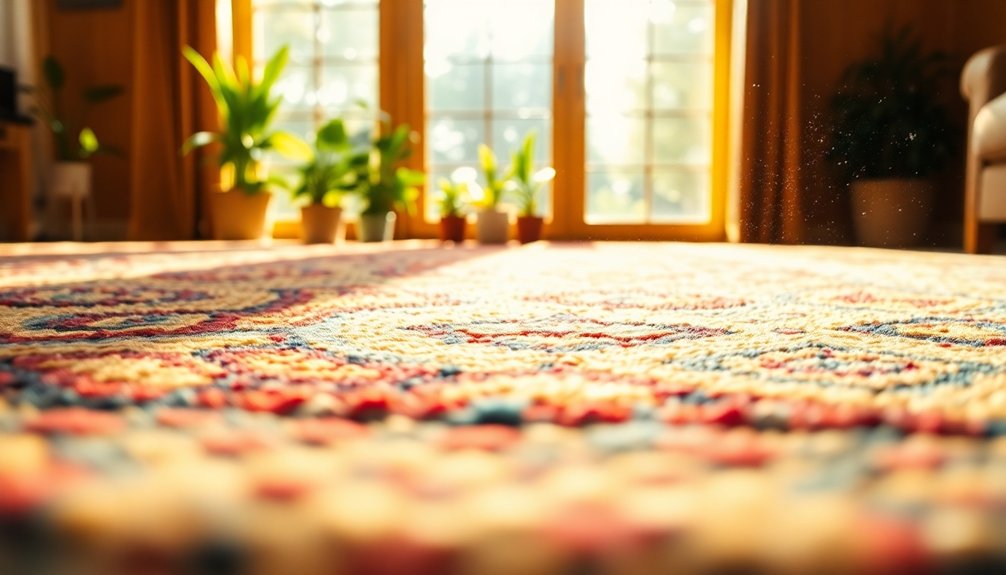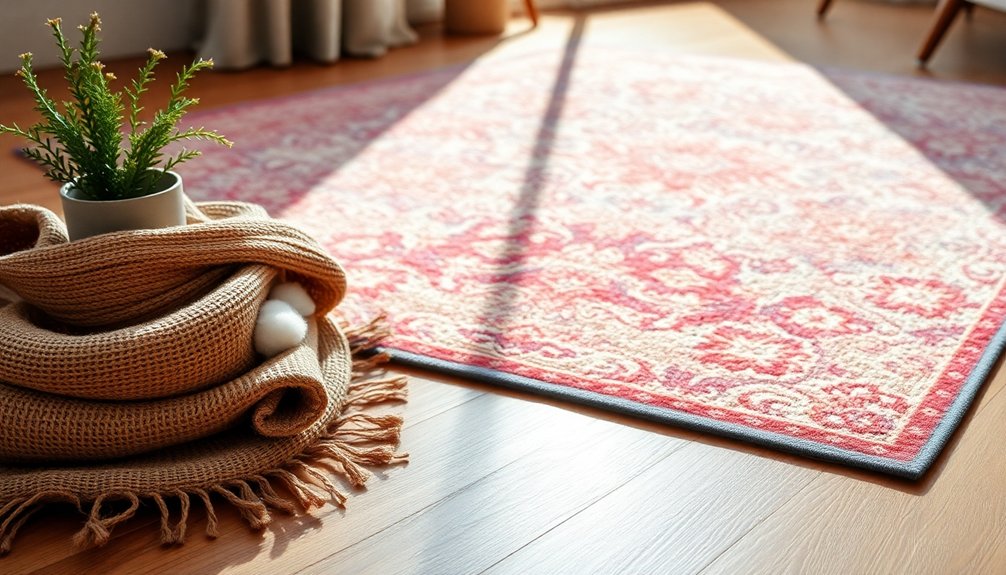Polypropylene rugs can pose health concerns primarily due to off-gassing volatile organic compounds (VOCs). You might experience respiratory issues, headaches, or skin irritation, especially if you're sensitive. While polypropylene is generally considered hypoallergenic, prolonged exposure could lead to more serious effects for some individuals, including potential impacts on the liver and central nervous system. Although they're durable and stain-resistant, it's crucial to check for rugs that meet safety standards to minimize risks. If you're curious about safer alternatives and their benefits, there's plenty more to uncover.
Key Takeaways
- Polypropylene rugs can off-gas volatile organic compounds (VOCs), potentially causing respiratory issues and irritation for sensitive individuals.
- Direct contact with polypropylene may lead to skin irritation or allergic reactions, particularly on dry skin.
- Long-term exposure to chemicals in polypropylene rugs raises concerns for liver, kidneys, and central nervous system effects.
- The lack of comprehensive studies on long-term health effects necessitates caution when using polypropylene rugs in living spaces.
- Certification standards like GOTS and OEKO-TEX can help consumers identify safer, lower-toxicity rug options.
Chemical Properties of Polypropylene
When examining the chemical properties of polypropylene, you'll find that it possesses a density ranging from 0.89 to 0.92 grams per cubic centimeter, giving it a lightweight yet durable quality. This material can appear either translucent or opaque, which makes it versatile for various applications. The predominantly isotactic crystal structure contributes to its strength and flexibility, allowing it to withstand stress without easily breaking.
Polypropylene has a melting point between 130 to 171 degrees Celsius, making it suitable for a range of thermal applications. However, be cautious, as it can melt or deform at high temperatures. With good thermal stability, it's sensitive to heat and friction, so you should avoid exposing it to extreme conditions. Additionally, polypropylene's chemical resistance helps it maintain integrity in various environments, making it a reliable choice for long-lasting products.
In terms of chemical resistance, polypropylene shows stability under normal conditions and resists many acids and alkalis. It also has low water absorption, making it hydrophobic, which is advantageous for items that need to resist moisture.
The melt flow rate varies, influencing its hardness and flexibility, while the molecular weight distribution affects its overall toughness. These properties make polypropylene a popular choice for many products, including rugs.
Health Risks Associated With Polypropylene
Polypropylene rugs, while popular for their durability and affordability, can pose several health risks that warrant attention. Here are some key concerns you should be aware of:
- Respiratory Irritation: Inhaling fine particles and VOCs can lead to respiratory issues, including irritation and potential asthma-like responses. Additionally, fumes from thermal processing can contribute to respiratory irritation.
- Skin Irritation: Direct contact with polypropylene may cause skin sensitivity or irritation, especially if the skin is dry, and can lead to allergic reactions.
- Gastrointestinal Irritation: Although rare, ingesting polypropylene could result in mild gastrointestinal disturbances, particularly if chemicals leach into food.
- Other Health Concerns: Exposure to VOCs can impact your liver and kidneys and may even affect your central nervous system.
It's crucial to consider these potential risks when choosing polypropylene rugs for your home.
While they may be budget-friendly, weighing the health implications against their affordability is essential for a safe living environment.
Keep these concerns in mind to protect your well-being and that of your loved ones.
Environmental Impact of Polypropylene Rugs

The environmental impact of polypropylene rugs is an important consideration for consumers seeking sustainable options for their homes. These rugs, derived from petroleum, contribute to climate change through significant greenhouse gas emissions. The energy-intensive production process relies heavily on fossil fuels, increasing dependence on non-renewable resources and releasing pollutants into the environment. Additionally, polypropylene rugs are known for their durability and resistance to wear and tear, which can extend their lifespan and reduce the frequency of replacement. Furthermore, polypropylene production also emits approximately 1.722 kg of oil equivalent greenhouse gases for every kg produced, contributing to climate change concerns.
Once you dispose of a polypropylene rug, you face additional environmental challenges. These rugs are non-biodegradable, leading to long-term waste management issues. They often end up in landfills or, if incinerated, release harmful pollutants into the air. Improper disposal can also contribute to ocean pollution, with polypropylene accounting for approximately 16% of total plastic waste in oceans.
Although recycling is possible, it's not widely practiced, making disposal even trickier. Fortunately, advancements in recycling technology offer hope. Innovative processes can recover high-grade polypropylene from discarded carpets, potentially producing materials of "virgin-standard" quality. This method aims to minimize energy use and greenhouse gas emissions.
When comparing environmental impacts, polypropylene rugs generally have a lower footprint than natural fiber rugs, using less water and energy during production. Plus, they don't require chemical treatments, making them a more eco-friendly choice overall.
Safety Standards for Rug Materials
Safety standards for rug materials are crucial for ensuring consumer protection and health. These standards help you make informed choices about the rugs you bring into your home.
Here are four key aspects of rug safety standards:
- Flammability Standards: Rugs must meet specific flammability criteria to reduce fire risks. Non-compliant rugs must be clearly labeled. Manufacturers often use materials with a high melting point, such as polypropylene, which is approximately 160°C, to meet these requirements.
- Chemical Safety: Many commercial rugs contain toxic chemicals that can impact indoor air quality and health. Look for rugs without harmful VOCs and PFAS. Polypropylene rugs are generally considered hypoallergenic, making them a safer option for sensitive individuals.
- Certification Standards: Certifications like GOTS and OEKO-TEX help you identify rugs made from non-toxic materials. These labels assure you of safety regarding chemical use.
- Regulatory Compliance: The Flammable Fabrics Act and various state regulations enforce safety standards, ensuring rugs meet necessary testing and labeling requirements.
Safer Alternatives to Polypropylene Rugs

When choosing a rug for your home, you might want to consider safer alternatives to polypropylene. Natural fibers like wool, cotton, and jute provide durability, breathability, and a soft feel without the risk of toxic chemicals. Wool is flame-resistant and biodegradable, while organic cotton is lightweight and free from pesticides. Jute is both renewable and requires no harmful fertilizers. Additionally, choosing rugs made from natural fibers can help improve indoor air quality (IAQ) by trapping allergens and pollutants. They also contribute to a reduced carbon footprint, especially when produced using materials like HDPE.
Bamboo viscose and hemp are other great options, offering hypoallergenic properties and minimal environmental impact.
If you prefer recycled materials, look for rugs made from recycled PET yarn or cotton; these not only reduce waste but are also non-toxic. Handmade rugs from eco-friendly materials ensure no harmful chemicals are present, similar to those found in poly lumber furniture.
Consider rugs made from seagrass or coir, which are durable, moisture-resistant, and biodegradable.
When selecting a rug, check for eco-friendly manufacturing practices, like a closed-loop system and third-party certifications, to guarantee sustainable production.
With so many stylish and environmentally friendly choices available, you can enhance your home decor while prioritizing your health and the planet.
Frequently Asked Questions
How Long Do Polypropylene Rugs Typically Last?
Polypropylene rugs typically last between 3 to 5 years, depending on your foot traffic and maintenance habits. With proper care, you can extend their lifespan, making them a durable choice for your home.
Can Polypropylene Rugs Be Safely Cleaned?
You can safely clean polypropylene rugs by vacuuming thoroughly, pressure-spraying with water, using a mild detergent, and ensuring they dry completely. Regular maintenance keeps your rugs looking fresh and extends their lifespan.
Do Polypropylene Rugs Have Any Odor?
Yes, polypropylene rugs can have odors. They might absorb pet accidents, moisture, or even chemicals from manufacturing. Regular cleaning and proper maintenance can help reduce these odors, keeping your space fresh and inviting.
Are Polypropylene Rugs Pet-Friendly?
Yes, polypropylene rugs are pet-friendly. They're non-toxic, durable, and stain-resistant, making them great for messy paws. Their tight weave minimizes snagging, ensuring your pets stay safe while enjoying their space.
How Do I Choose a Safe Polypropylene Rug?
When choosing a safe polypropylene rug, look for certifications, low VOC emissions, and reputable brands. Ensure it's made without harmful chemicals, and consider durability and recyclability for long-term environmental and health benefits.

